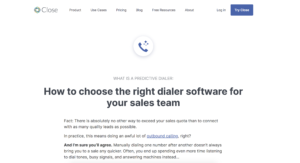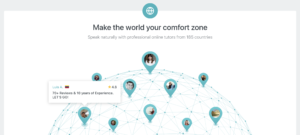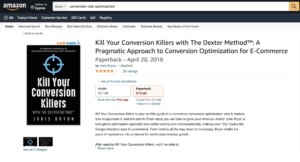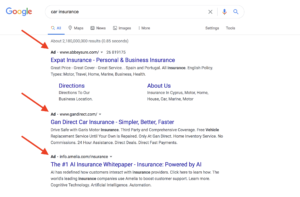As the importance of eCommerce rises in the wake of the COVID-19 pandemic, the urgency to learn how to increase website conversion also rises each day.
More people are at home, which means more people are online. Are you doing everything to convert more visitors to customers?
While the pandemic hit many businesses hard, it has also provided an opportunity for many. Whether you consider the glass half empty or half full, one thing is for sure – this is the time to up your online business game. Starting with boosting your site’s conversion.
Here are 3 simple steps to increase your website conversion rates easily.
1. Bring Confidence, Creativity, and Clarity to Your Offer
Shane Cassells, former Advanced Performance Specialist at Google says about 50% of people don’t buy something, simply because they can’t find what they’re looking for. Is your website letting this happen? If yes, it’s probably crippling your conversion.
From your website’s main headline to layout, everything should make it easy for your visitors to see what they came to see. It’s your job to ensure they can easily figure out what you’re offering and exactly why they might benefit from your product specifically. Graphics play an important role in website or product impressions. Make sure you’re paying attention to it. Here’s a guide on how to do it properly.
Ensure your visitors easily find your offer, an offer that tells them exactly why they should buy from you. For instance, instead of a generic CTA for a cosmetic store, like “Get yours today”, create an enticing offer like “Reveal your true beauty”. Most people get this wrong by either coming off as too “salesy” or by failing to capture the visitors’ attention at all.
Consider how Monterey Premier’s blog page has individual colors assigned to each type of article category. This helps users easily navigate to an article of their interest, increasing conversions.
If you have a particularly technical service that you want the common people to use, start by explaining your service to a layman in simple terms, like this predictive dialer for example:
The idea is to make your product more practical and accessible in the eyes of more and more people.
Make sure you’re not overdoing it, that will only hurt your conversion. Rather, subtly convince your visitors that what you’re offering is better than everyone else.
The Detox Austin website makes a great example to see all the above in one place. Easy-to-use layout, impressive and relevant graphics, and clarity in what they offer.
2. Re-evaluate Your Checkout Process
In March 2020, about 88% of shopping carts were abandoned. So if you’re out to increase your website conversion, you need to take a good hard look at your checkout process.
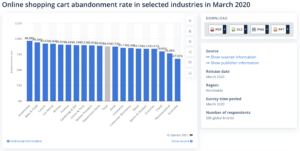
There may be several problems in your checkout process that are eating away your site conversion. Here are some of the top reasons why people abandon the shopping cart:
- Hidden costs: Make sure to provide product descriptions and the proper cost for each product. If shipping and taxes are calculated at the checkout, make sure it’s visible and added to the total cost for the customer’s ease. Almost a quarter of people leave the checkout process when they see hidden costs added to their final payable amount.
- Forced registrations: Forcing your customers to register an account on the website before they use the service or make a purchase often causes them to abandon the idea altogether. Instead, allow for guest checkout options and eliminate the need for an account.
- Lengthy checkout process: Many websites tend to have a needlessly long checkout process. This might force users to abandon their carts mid-process. To make it easier, make sure you’re only asking for relevant details, have relevant drop-downs for each option, the fonts are clear and big enough for each section.
- Slow loading: Longer loading times are a definite conversion killer. Minimize the loading time during the checkout process by eliminating needless graphics or other things that might be slowing down the checkout pages (or any site page for that matter).
- Limited payment options: Make sure you have the most popular common payment method as an option. This will help cater to a wider audience, alienating little to no potential customers.
- Not mobile-friendly: With most people using their phones to shop online, it’s good to take the time and develop separate mobile and desktop versions of your website. People frustrated with how your site runs on their phone probably won’t be buying anything from you.
- Unsecure website: Make sure your website is registered and secure for your users. Any suspicious malware is automatically detected by most anti-virus programs that prevent the website from loading altogether.
Also, consider adding social proof close to the CTA and where people are actually buying the product. The success stories on this tutoring website are a great example of this in action. They appear automatically at the bottom of the page and are easy to read. You can just swipe to read more.
Adding testimonials below a featured product near the purchase button is also a great way to boost conversions. Enabling customer reviews on your products is also a good idea. You might want to divide them by ratings as Amazon does.
Remember that checkout practice and payment options keep evolving. Be sure to keep your website updated.
3. Invest in Targeted Advertising
When thinking of boosting site conversions, you really need to reconsider the ways you’re getting traffic. This is especially relevant in a post-COVID world where businesses, in general, have to work with lower ad spends. Online businesses are booming, but they too have to be more careful with their advertising.
The pandemic has forced a lot of businesses to slash their advertising and marketing budgets. As you’re trying to generate quality traffic, make sure to study and analyze how your site generated traffic in the past and what practices gave you the highest yield. If you’re new to the field, you can always make the most of your limited advertising budget by knowing your website’s conversion potential and your target demographic.
For example, if you’re catering to young adults or teens, you might want to invest more in ads through social media. Since those will reach your target audience more readily.
However, if you want adults and middle-aged people on board, you might want to use Google Ads or similar services that are more accessible to that demographic. Google Ads are also a more preferred option since everyone uses the search engine.
Make sure you’re not blatantly advertising your product in places where it has no relevance. This would be a waste of money and time for you. Instead of firing blindly and hoping to hit something, think more like a sniper. Highly focused and precision targeting.
4. [Bonus] Track Your Conversions
You can only optimize what you can measure. This also holds true for conversion tracking.
With conversion tracking you can:
-Track your ROI
-Improve elements of your campaign that need improvement
-Identify the best performing content, and reuse it
-Improve your audience segmentation
-Spend your marketing dollars where they matter most
-Improve your site UX
-Collect data for continuous improvement
Here are the most important conversion metrics you should be tracking:
-Traffic sources
-Interactions per visit
-Value per visit
-Bounce rate
-New visitor conversion rate
-Returning visitor conversion rate
-Cost per conversion
-Exit pages
With effective tracking tools like CrazyEgg and Hotjar, you can measure the behavior of your site visitors. These tools let you use techniques such as heatmaps and A/B split testing to help you zoom in on crucial site elements affecting your conversion.
Final Thoughts
Increasing your website conversion should always be a top priority. Especially if you see your online sales dwindling. Whether you’re an established business or learning how to make money online, the effective strategies will help you boost your conversion rates.
You need to figure out a way to convince total strangers on the internet that your website or your product is worth their time, attention, and wallet. Keep the key steps covered here in mind – they’ll serve you well regardless of your industry and niche. You can always look at more comprehensive guides – the learning should never stop.
Remember, there’s no shortcut to success and that success might not always be linear. It takes a while before results start showing. But know this – the time you invest in improving conversion for your website right now is always worth it.
Burkhard Berger is the founder of awesomex™. You can follow him on his journey from 0 to 100,000 monthly visitors on www.awesomex.com. His articles include some of the best growth hacking strategies and digital scaling tactics that he has learned from his own successes and failures.


